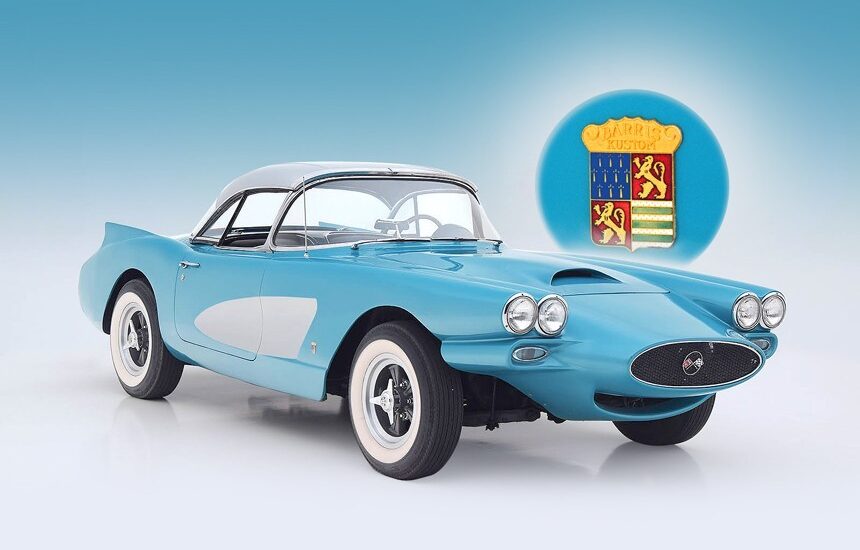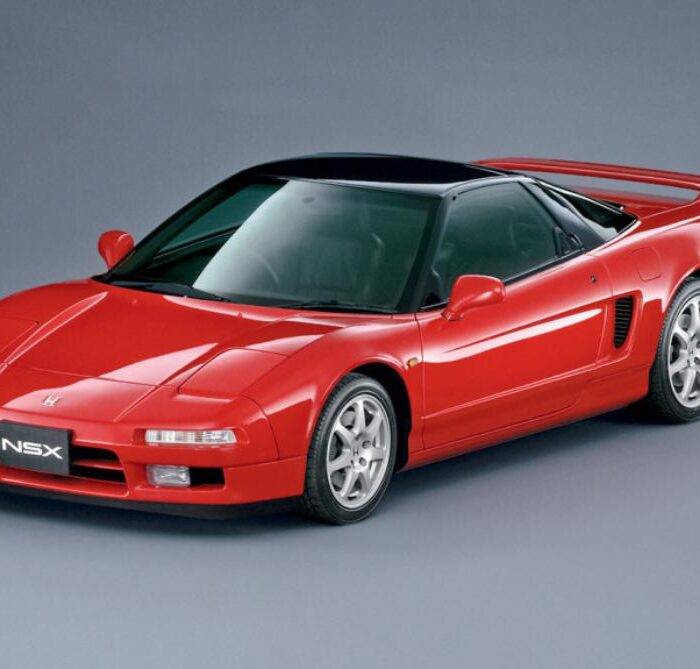À première vue, ce véhicule peut sembler être une version légèrement modifiée de la Corvette XP-700 expérimentale de 1958. Cependant, le prototype original n’a pas survécu; il a été transformé en Corvette Mako Shark I. Alors, qu’avons-nous exactement sous les yeux? Il ne s’agit ni d’une réplique, ni d’une simple répétition.


Le tableau de bord est également, en général, standard – mais le volant avec une jante en bois est très probablement un produit d’Accessories International: le volant des voitures de série n’est pas comme celui-ci
La voiture présentée ici est basée sur une Corvette de 1958, mais sa personnalisation est intervenue bien plus tard, vers le milieu des années 1960. La commande émane d’Accessories International, une société californienne spécialisée dans le marché des accessoires automobiles – principalement des éléments décoratifs tels que des revêtements, des moulures, des couvercles de soupapes chromés, des boîtiers de filtres à air personnalisés et d’autres pièces ornementales. L’entreprise a acquis ce véhicule d’occasion et l’a confié à l’un de ses principaux clients, Barris Kustom de Los Angeles.

Le levier de transmission porte fièrement le mot «HURST»: cette entreprise, fondée en 1958, fournissait des équipements de sport et de course pour des voitures de différentes marques

La main courante située devant le siège du passager est appelée familièrement «sissy bar», et le mot «sissy» ne signifie pas «sœur», mais «lâche», «fille». Par exemple, si vous avez tellement peur de conduire vite, attrapez, accrochez-vous…
George Barris, fondateur de Barris Kustom, est reconnu comme un pionnier de la personnalisation automobile, un mouvement qui perfectionne les véhicules de série en leur apportant des modifications externes et parfois internes uniques, réalisées à l’aide de techniques artisanales traditionnelles. Ce mouvement va souvent à l’encontre des tendances automobiles dominantes, telles que la décoration extérieure excessive des voitures de série des années 1950.


Le traitement frontal de la voiture reproduit assez fidèlement celui du prototype XP-700, même si ce n’est pas sans déviations. Ainsi, les phares auraient dû être surmontés de petites visières, et les feux latéraux avant dans les ouvertures des prises d’air supplémentaires du système de refroidissement ont également l’air légèrement étrangers
Il est intéressant de noter que le véritable auteur de cette légende de la personnalisation n’est pas George Barris, mais Georgios Barkaris, d’origine grecque et immigré de la première génération. Après la mort de sa mère, lui et son frère aîné, Sam, ont été adoptés par leur oncle et ont pris son nom de famille, Barkaris. Les frères étaient inséparables, partageant des intérêts pour la musique et le théâtre, et peignant même ensemble une couleur vibrante et accrocheuse sur leur première voiture, une Buick 1925 hors d’usage.

L’arrière a été réalisé en référence à un autre prototype de General Motors, la Buick Wildcat II (1954)

Les roues de la XP-700 d’origine étaient à rayons – et ici, comme nous le voyons, ce sont des produits d’Accessories International
Pendant la Seconde Guerre mondiale, alors que Sam est enrôlé dans la marine, George s’installe à Los Angeles. Son talent pour la modification des véhicules ne passe pas inaperçu: ses camarades militaires, impressionnés par ses serrures de porte personnalisées – dépourvues de poignées externes – lui suggèrent de poursuivre une carrière dans la carrosserie automobile. George finit par ouvrir son propre atelier dans une banlieue de Los Angeles, qui prospère et déménage au cœur de la ville, sous le nom de Barris Kustom.



Le travail de George Barris a attiré l’attention de Robert Petersen, fondateur du magazine Hot Rod, ce qui a permis de faire connaître les créations de Barris à un public plus large. Même l’industrie cinématographique s’intéresse à ses créations uniques, propulsant George Barris sur le devant de la scène de la personnalisation. Ses projets ont été présentés dans des films et utilisés par des studios de télévision, qui avaient besoin de véhicules réimaginés de manière créative pour leurs productions.


Outre la gestion de son entreprise prospère, Barris était un promoteur actif du mouvement des voitures personnalisées. Il est l’auteur de nombreux articles offrant des conseils et des comptes rendus détaillés de ses projets, ce qui a contribué à populariser le métier.

Le chrome brillant du compartiment moteur provient des mêmes produits Accessories International pour lesquels cette voiture a été créée.
La Corvette bleue présentée ici a été fabriquée presque par hasard, car Barris était un utilisateur fréquent des produits d’Accessories International. Il s’est réjoui de l’occasion qui lui était donnée de mettre en valeur ces produits dans l’un de ses projets. L’avant de la voiture s’inspire du prototype XP-700, aujourd’hui disparu, que Barris a recréé de mémoire. Il a repris la prise d’air ovale caractéristique du radiateur et la composition générale de l’avant, mais a laissé de côté les éléments non fonctionnels mais élégants tels que les «ouïes» latérales.
Quant à l’arrière de la voiture, s’il reprend le design que l’on retrouvera plus tard sur les modèles de production 1961/1962 de la Corvette, Barris y a ajouté de petites «ailettes», une caractéristique jamais vue sur les Corvettes auparavant. Le projet s’est achevé par une exposition de divers accessoires rutilants d’Accessories International, démontrant le mélange complexe de la fonction et de la mode.

Et voici à quoi ressemblait le vrai prototype du XP-700. Sentez la différence, comme on dit.
Alors que Sam Barris a pris sa retraite et est décédé en 1967, George Barris a continué à innover et à influencer le monde de l’automobile jusqu’à sa mort en 2015, juste avant son 90e anniversaire. Son héritage en tant qu’icône du style et pionnier de la personnalisation automobile perdure, captant l’imagination des passionnés de voitures et l’esprit d’innovation.
Il est dommage, en effet, que de tels talents disparaissent, mais leur impact résonne à travers les décennies.

La plastique des flancs est résolue beaucoup plus calmement que sur le prototype XP-700: il n’y a pas d’ouïes derrière les passages de roue avant, pas de prises d’air devant les passages de roue arrière, et le collecteur d’échappement qui court tout le long de la carrosserie est absent. Le hard top amovible est de série, il est seulement «décoré» de fentes d’aération au-dessus de la lunette arrière.
Il s’agit d’une traduction. Vous pouvez lire l’article original ici : Рекламобиль : кастомизированный Chevrolet Corvette 1958 года в рассказе Андрея Хрисанфова

Publié Novembre 07, 2024 • 6m à lire





